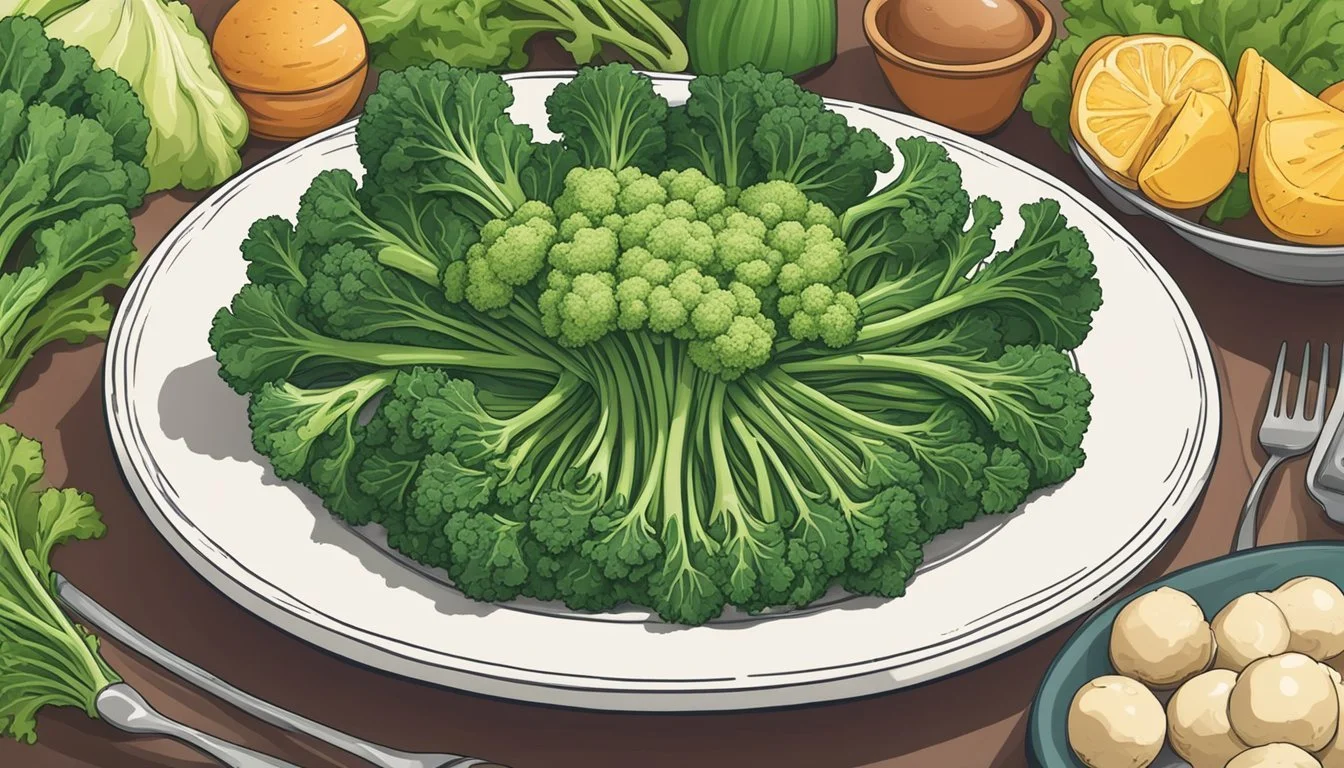What Are the Health Benefits of Rapini?
Unveiling Nutritional Advantages
Rapini, commonly known as broccoli rabe, is a leafy green vegetable that belongs to the Brassica family, which also includes broccoli, Brussels sprouts, and cabbage. Though it shares a name and a slight visual resemblance with broccoli, it boasts a distinct, slightly bitter taste and is closer in relation to the turnip. It is recognized not only for its unique flavor profile but also for its remarkable nutritional content.
This nutritious vegetable is an excellent source of vitamins A, C, and K, and provides minerals such as iron, calcium, and potassium. The health benefits of rapini are significant due to its rich composition of nutrients and antioxidants. Regular consumption of rapini may support bone health, thanks to its high vitamin K content, while the presence of vitamin C bolsters the immune system and contributes to the maintenance of healthy skin and tissues.
Moreover, the vegetable contains glucosinolates, compounds known for their potential cancer-fighting properties. Its low-calorie profile coupled with a good amount of dietary fiber also makes rapini a great choice for those looking to maintain a healthy weight while ensuring adequate nutrition. In addition to these benefits, rapini is believed to offer anti-inflammatory effects and has been linked to cardiovascular health, demonstrating its broad impact on overall well-being.
Nutritional Profile of Rapini
Rapini, commonly known as broccoli rabe, is not just a tasteful addition to a variety of dishes; it is packed with a wealth of essential nutrients. It provides an impressive range of vitamins and minerals while also offering beneficial macronutrients and fiber.
Vitamins and Minerals
Rapini is a nutritional powerhouse when it comes to vitamins and minerals. It notably provides:
Vitamin C: Plays a significant role in immune function and skin health.
Vitamin K: Essential for blood clotting and bone health.
Vitamin A: Important for vision, the immune system, and reproduction.
Calcium: Vital for bone health and muscular function.
Iron: Crucial for the formation of red blood cells and transport of oxygen.
Potassium: Necessary for blood pressure regulation.
Magnesium: Involved in over 300 enzymatic reactions in the body.
Zinc: Aids in immune function and wound healing.
Folic Acid: Important for proper brain function and plays an essential role in mental and emotional health.
Macronutrients and Fiber
When examining the macronutrients in rapini, one finds it to be low in calories and fat, making it a suitable food for those managing their weight. It also contains:
Protein: Essential building block for muscles and tissues.
Dietary Fiber: Beneficial for digestive health and maintaining healthy blood sugar levels.
Carbohydrates: Provides the body with energy.
Rapini's balanced composition of nutrients makes it an excellent addition to a balanced diet.
Health Benefits of Rapini
Rapini, also known as broccoli rabe, offers a variety of health benefits due to its rich nutritional profile which includes vitamins, minerals, and potent phytochemicals. These nutrients contribute to its antioxidant properties, support heart and bone health, may help prevent certain cancers, and aid in maintaining a healthy digestive system.
Antioxidant Effects
Rapini is high in antioxidants like vitamin C, vitamin A, and sulforaphane, all of which help protect the body from oxidative stress. Vitamin A in particular, contributes to eye health, as it contains beta-carotene which the body converts into the active form of the vitamin. Lutein, another antioxidant present in rapini, is known for protecting the eyes.
Heart Health
Rich in folate and potassium, rapini contributes to heart health by managing blood pressure levels and reducing homocysteine, an amino acid linked to heart disease. The anti-inflammatory effects of the glucosinolates in rapini may also help prevent arterial damage, thus supporting a healthy cardiovascular system.
Bone Health
Crucial for bone health, rapini contains vitamin K and calcium. Vitamin K is a key component in bone metabolism and may reduce the risk of osteoporosis. Regular consumption of rapini, with its combination of calcium and vitamin K, can be beneficial for maintaining strong bones.
Cancer Prevention
Glucosinolates found in rapini are converted into isothiocyanates which have shown potential in cancer prevention. Studies suggest that these compounds may induce apoptosis in cancer cells and may particularly be beneficial in reducing the risk of ovarian cancer. However, it should be noted that these effects require more comprehensive studies for conclusive evidence.
Digestive Health
The dietary fiber in rapini aids in maintaining digestive health by helping to regulate bowel movements, which may assist in controlling blood sugar levels. This is particularly beneficial for individuals managing diabetes, as well as for the general population to maintain a balanced digestive system.
By incorporating rapini into the diet, individuals may gain an array of health benefits that contribute to overall well-being.
Incorporating Rapini into Your Diet
Rapini, also known as broccoli rabe, is a nutrient-rich leafy green that can bring both flavor and health benefits to a variety of dishes. This member of the brassica family boasts a somewhat bitter taste that complements the flavors of garlic, olive oil, and robust Italian ingredients.
Cooking Methods
When preparing rapini, steaming is a gentle method that preserves its delicate flavor and essential nutrients, such as vitamins A, C, K, and minerals like calcium and iron. If a milder taste is preferred, blanching rapini in boiling water for one to two minutes before sautéing can reduce its bitterness. For a simple and health-conscious approach, sautéing with olive oil, garlic, and a pinch of sea salt enhances its natural flavor profile while maintaining a majority of its antioxidants, beneficial for reducing inflammation and protecting against free radicals.
Recipe Ideas
Pasta with Rapini:
Boil rapini until tender, chop, and sauté with garlic, onion, and red pepper flakes.
Toss with cooked pasta, a drizzle of olive oil, and top with grated Parmesan cheese.
Sausage and Rapini:
Brown sausage in a pan and set aside.
In the same pan, sauté rapini with garlic and red pepper flakes, then combine with sausage.
By incorporating rapini into dishes like these, one not only adds depth to the flavor but also integrates a significant source of vitamins and minerals that can contribute to better cholesterol levels and gut health.
Comparative Analysis With Related Vegetables
Rapini, also known as broccoli raab or broccoletto, stands distinct in the family of cruciferous vegetables due to its unique flavor profile and nutrient content. This section presents a comparative analysis with related vegetables to understand its health benefits in context.
Rapini Versus Broccoli
Broccoli, a closely related vegetable, is milder and less bitter than rapini. It shares the family name Brassica, but belongs to the species Brassica oleracea compared to rapini's Brassica rapa.
Flavor: Rapini is noticeably more bitter which can be reduced through cooking methods such as boiling. Broccoli lacks this bitterness and is often enjoyed both raw and cooked.
Nutrients: While both vegetables are low in calories and rich in vitamins, rapini has a higher concentration of certain nutrients such as vitamin C and phosphorus.
Cooking: Broccoli florets are commonly used in a variety of dishes from oven-roasted to stir-fries, whereas rapini, with its leafy shoots and smaller buds, is often sautéed with garlic and salt or added to pasta dishes.
Rapini Versus Other Leafy Greens
Compared to other leafy greens such as turnip greens and cabbage, which originate from similar regions like China, rapini holds its own in terms of flavor and nutrition.
Flavor: Rapini has a distinct bitter taste, which sets it apart from the milder flavor of many leafy greens.
Nutrients: It is nutrient-dense, providing a good source of fiber, antioxidants and high levels of vitamin C, making it an excellent addition to a healthy diet.
Cooking: Unlike some leafy greens that can become quite wilted with heat, rapini retains a pleasant texture after cooking, making it versatile in culinary applications.
Both broccoli and other leafy greens provide valuable nutrients and health benefits, yet rapini boasts unique flavors and can be a more nutrient-dense alternative in a well-balanced diet.
Frequently Asked Questions
Rapini, also known as broccoli rabe, offers a variety of health benefits, each supported by its dense nutritional profile. These FAQs explore how its inclusion in your diet can contribute to overall health and wellness.
How does rapini contribute to a healthy diet?
Rapini is a nutrient-dense food rich in vitamins A, C, and K, minerals like calcium, iron, and potassium, and dietary fiber. It provides essential nutrients while being low in calories, thus supporting a balanced and healthy diet.
Are there any weight management benefits associated with eating broccoli rabe?
Broccoli rabe is low in calories, with only about 9 calories per serving, and high in fiber. These properties may contribute to weight management by promoting a feeling of fullness and reducing overall calorie intake.
How does the nutritional content of broccoli rabe compare to that of traditional broccoli?
While both vegetables are nutritionally valuable, broccoli rabe offers a different profile, including higher levels of certain vitamins and nutrients such as vitamin K and potentially more iron and calcium per calorie than traditional broccoli.
Can including rapini in your diet have a significant impact on fiber intake?
Yes, rapini is a good source of dietary fiber, which is important for digestive health. Including it in one's diet can contribute to reaching the recommended daily intake of fiber.
What potential health advantages might rapini have over other leafy greens?
Rapini is particularly rich in glucosinolates, compounds that have been studied for their potential to reduce the risk of certain cancers. Compared to other leafy greens, rapini also has higher levels of certain nutrients like vitamin K and iron.
Are there cardiovascular health benefits linked to consuming rapini?
Consuming rapini may support cardiovascular health due to its content of antioxidants like vitamin C, folate which aids in reducing homocysteine levels, and potassium that can help maintain healthy blood pressure levels.





